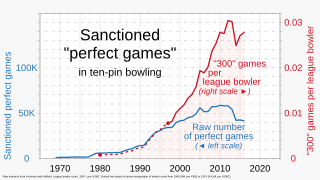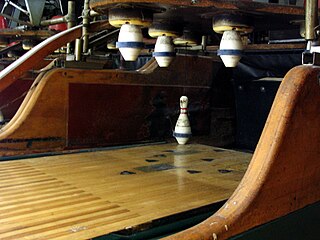
Five-pin bowling is a bowling variant which is played in Canada, where many bowling alleys offer it, either alone or in combination with ten-pin bowling. It was devised around 1909 by Thomas F. Ryan in Toronto, Ontario, at his Toronto Bowling Club, in response to customers who complained that the ten-pin game was too strenuous. He cut five tenpins down to about 75% of their size, and used hand-sized hard rubber balls, thus inventing the original version of five-pin bowling.

Ten-pin bowling is a type of bowling in which a bowler rolls a bowling ball down a wood or synthetic lane toward ten pins positioned evenly in four rows in an equilateral triangle. The objective is to knock down all ten pins on the first roll of the ball, or failing that, on the second roll.

Skittles is a historical lawn game and target sport of European origin, from which the modern sport of nine-pin bowling is descended. In regions of the United Kingdom and Ireland the game remains as a popular indoor pub game.

Candlepin bowling is a variation of bowling that is played primarily in the Canadian Maritime provinces and the New England region of the United States. It is played with a handheld-sized ball and tall, narrow pins that resemble candles, hence the name.

Duckpin bowling is a variation of the sport of bowling.

A perfect game is the highest score possible in a game of bowling, achieved by scoring a strike in every frame. In bowling games that use 10 pins, such as ten-pin bowling, candlepin bowling, and duckpin bowling, the highest possible score is 300, achieved by bowling 12 strikes in a row in a traditional single game: one strike in each of the first nine frames, and three more in the tenth frame.

In bowling, a pinsetter or pinspotter is an automated mechanical device that sets bowling pins back in their original positions, returns bowling balls to the front of the alley, and clears fallen pins on the pin deck. Prior to the machine's invention, pinsetters were boys or young men hired at bowling alleys to manually reset pins and returned balls to the player. The first mechanical pinsetter was invented by Gottfried (Fred) Schmidt, who sold the patent in 1941 to AMF. Pinsetting machines have largely done away with pinsetting as a manual profession, although a small number of bowling alleys still uses human pinsetters. While humans usually no longer set the pins, a pinchaser is often stationed near the equipment to ensure it is clean and working properly, and to clear minor jams.

Bowling is a sports video game published in 1979 by Atari, Inc. for the Atari VCS. It was programmed by Larry Kaplan who left Atari to co-found Activision the same year. The game is an interpretation of the sport bowling, playable by one or two players.
A split is a situation in ten pin bowling in which the first ball of a frame knocks down the headpin but leaves standing two or more non-adjacent groups of one or more pins. Scoring a spare in this situation is often referred to as a "killer shot".

Celebrity Bowling was an American syndicated bowling sports series hosted by Jed Allan that ran from January 16, 1971, to September 1978. The series was produced in Los Angeles at Metromedia Square, the studios of KTTV.

In bowling, a strike means that all of the pins have been knocked down on the first ball roll of a frame. On a bowling scoresheet, a strike is marked by an "X".
Bowlliards is a pool game often used as a training drill. The game borrows aspects of ten-pin bowling, hence the name. The game is divided into ten frames where a player gets a maximum of two innings to pocket ten balls.

Basque bowls, is one of the few Basque rural sports which do not originate in an activity related to rural or marine work. It has a number of other names too and is played in a bolatoki or bolaleku "bowls place" which often consists of a playing area in the open, an open sided structure with a low roof or a playing area located inside a colonnaded hallway.

Nine-pin bowling is a bowling game played primarily in Europe. European championships are held each year. In Europe overall, there are some 130,000 players. Nine-pin bowling lanes are mostly found in Austria, Czech Republic, Slovakia, Belgium, Germany, Luxembourg, the Netherlands, Estonia, Switzerland, Serbia, Slovenia, Croatia, Poland, North Macedonia, Hungary, Brazil and Liechtenstein.

In ten-pin bowling, a Dutch 200 is a game in which the bowler records a score of 200 by getting strikes and spares in alternation throughout the game. Strikes, when thrown in the even-numbered frames, require six spares. For strikes in the odd-numbered frames, five spares are needed, with a strike on the last shot of the game. When bowled in certified play, the certifying body may issue a patch or other award commemorating the feat.

Bowling is a target sport and recreational activity in which a player rolls a ball toward pins or another target. The term bowling usually refers to pin bowling, though in the United Kingdom and Commonwealth countries, bowling could also refer to target bowling, such as lawn bowls.

Bowling Revolution P★League is a series of Japanese women-only bowling tournaments, developed solely for television. Entry into these tournaments is limited to selected members of the Japan Professional Bowling Association (JPBA), and amateurs who have qualified via open auditions. The show airs throughout Japan on BS Nittele (BS日テレ).
The World Bowling Tour, a major professional tour, unites bowlers from selected major professional and amateur organizations through a series of events organized by World Bowling.
Bowling Solitaire is a patience or solitaire card game that uses a single deck standard playing cards to simulate a round of ten-pin bowling.


















